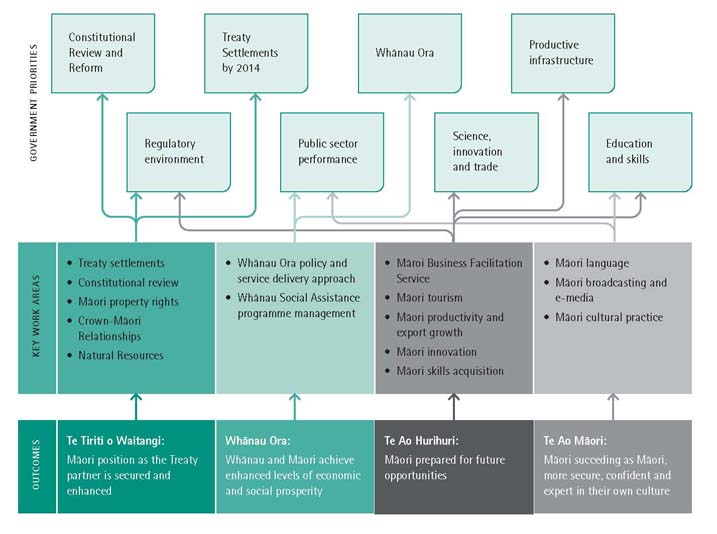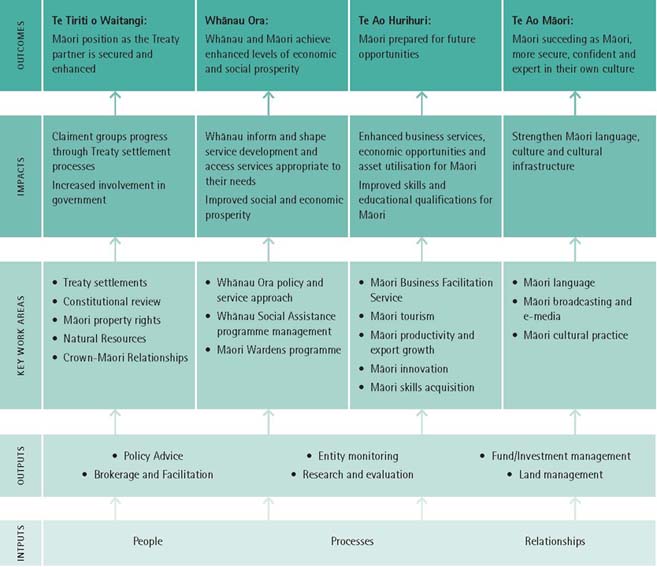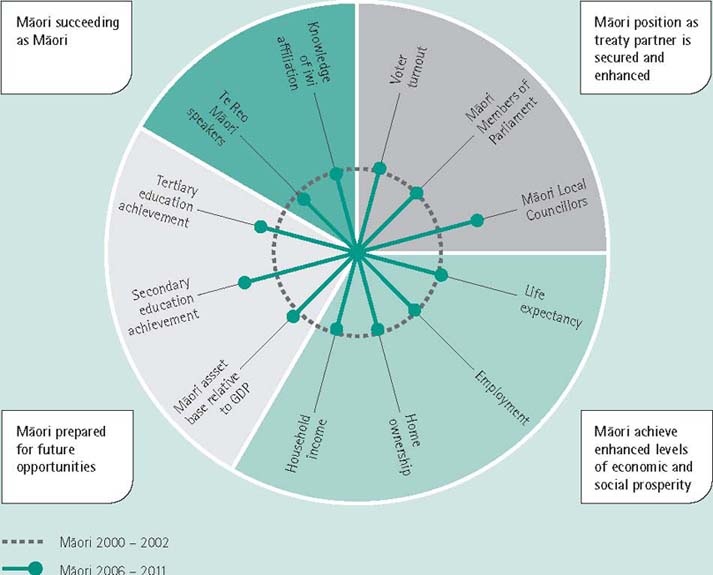
Statement of Intent 2011-2014
Table of contents
- Foreword from Ministers
- Ministerial Statement of Responsibility
- Introduction from the Chief Executive
- Chief Executive Statement of Responsibility
- Nature and Scope of Functions
- Strategic direction
- Operating Intentions
- Managing in a changeable operating environment
- Assessing organisational health and capability
- Appendix 1: TPK's Main connections with other agencies
- Appendix 2: How Crown Entities and the Māori Trustee contribute to TPK's Outcomes.
Strategic direction
Links to Government's priorities
We intend to address Government’s expectations over the medium term through a particular focus across the Ministerial priorities of Māori Culture and Indigenity; Crown-Māori Relationships; Māori Economic Opportunities; Whānau Ora and Whole of Government Effectiveness for Māori. The key work areas under each of these priorities are captured within our Outcome Framework and detailed in the Operating Intentions section of this document.
The Government’s overriding priority is to grow the economy to deliver greater prosperity, security and opportunities for all New Zealanders. To progress this, government has identified six key policy areas that present opportunities to lift growth and create jobs. These are:
- strengthening the tax system - improving incentives to work, save and invest;
- public sector performance – delivery of better, smarter and quality public services;
- education and skills – increasing individuals ability to help firms innovate and be more productive;
- science, innovation and trade – assisting firms to grow and innovate, raising productivity levels across the economy;
- regulatory environment – removal of unnecessary regulatory barriers to enterprise and business opportunity; and
- productive infrastructure – investing appropriately to support economic growth.
Our long-term outcome of “Te Ao Hurihuri: Māori prepared for future opportunities,” is specifically focused on achieving positive impacts for Māori across the Government’s economic policy areas of; education and skills; science, innovation and trade; and productive sectors.
Specific contributions to the Government’s economic policy area of improving public sector performance are captured through the following long-term outcomes and guiding principles:
- “Whānau Ora: Whānau and Māori achieve enhanced levels of economic and societal prosperity” – the Whānau Ora delivery approach will improve the way public agencies and their contracted agents interact with Whānau;
- “Te Ao Māori: succeeding as Māori, more secure, confident and expert in their own culture” - reform of the Māori language sector; and
- “Government is effective for Māori” -improving the effectiveness of the State Sector for Māori.
Other Government policy priorities that are at the heart of our core role as principal advisor to Government on Crown-Māori relationships include; Treaty Settlements by 2014, and Constitutional Review and Reform. Our long-term outcome of “Te Tiriti o Waitangi: Māori positioned as the Treaty partner is secured and enhanced,” makes specific contributions across these policy priorities.
Figure 1 summarises the main links between our Outcomes and the Governments policy drivers.

Outcome framework
As illustrated above, our outcome framework has, and continues to align closely to the priorities of Government. These, together with our wider Crown-Māori relationship responsibilities and statutory responsibilities, particularly in respect to the Māori language, signal the medium term direction for Te Puni Kōkiri.
The diagram on page 16 represents our Outcome Framework; identifying the key work areas we will progress, in response to Ministerial Priorities, and resultant impacts attributable to each Outcome.
1 Extracted from Budget Policy Statement 14 Dec 10; and Prime Minister’s Statement to parliament 8 Feb 11.
Figure 2: Te Puni Kōkiri Outcome Framework

Details on each outcome, our work programme, and how we will measure progress can be found in the Operating Intentions section of this document and in the Information Supporting the Estimates for Vote Māori Affairs.
Our outcome framework reflects key dimensions of the Treaty of Waitangi: he aha te mea nui o te ao... and tino rangatiratanga.
He aha te mea nui o te ao? He tangata, he tangata, he tangata reflects the principal importance of Māori people, and our focus on optimising the combined cultural, social and economic wellbeing of them, and the kinship and other collectives to which they belong, according to their own preferences and norms.
When viewed from the perspective of a government agency with a core role as principal adviser on Crown-Māori relationships, Tino Rangatiratanga is expressly provided for in the Treaty, and through the interpretations of the Waitangi Tribunal and Courts is required to be actively protected by the Crown as part of the ‘essential bargain’ through which the Crown acquired the authority to govern. Active protection extends beyond the Article 2 dimensions to which it is specifically ascribed, to all matters which Māori consider to be important to their development, quality of life and culture.
Our policy approach asserts our view that, in all circumstances, Māori themselves are best placed to express their own development needs and aspirations, have the capability to achieve those aspirations, and that this is best supported in ways that build on the strengths evident in Māori cultural constructs. We therefore seek to develop public policy in ways that reflect these strengths and aspirations, and we are moderated by kaupapa Māori values to ensure that our advice is anchored in not just what is important to Māori, but also is developed in ways that are respectful of and appropriate to Māori.
The key outcomes identified in our outcome framework reflects the changing economic conditions and government priorities. While our immediate emphasis has previously been on supporting Māori during a difficult economic climate, we have shifted that approach to building whānau resilience and self-reliance. We have retained our ongoing emphasis on being future focused and building on the inherent cultural strengths of Māori people and communities. Underpinning these priorities is the continued focus on the Treaty of Waitangi as the constitutional basis for New Zealand society, and securing and enhancing the rights and interests, and reciprocal obligations, of whānau, hapü, iwi and Māori as tangata whenua, and as partners in the Treaty.
Contributing to Government’s priorities, including achieving positive outcomes for Māori, is the responsibility of every agency of state. All New Zealanders want to have good health, be well educated, live in a healthy environment, have adequate housing, have access to meaningful employment, feel secure, have their culture accessible and utilised by themselves and valued by others, and enjoy a state of well being. Our interest in all of these areas is to work closely with agencies that have the primary responsibility for these outcomes to ensure that outcomes for Māori are equitable, and enable them to fulfil their aspirations and realise their own potential.
How we will measure progress
The outcome indicators we have selected reflect critical information that we are interested in with respect to each outcome. Each of the outcome indicators provides baseline data and subsequent trends.
In some cases, Government has not set targets for these indicators: accordingly, we have limited our expression of outcome targets to those that have already been agreed by Government. We will however work with other agencies to develop outcome targets to reflect effectiveness for Māori.
Figure 3 below depicts the baseline data (2006-10) for key outcome indicators, and shows recent trends in these indicators (progress since 2000-02).2 Our influence on the stated outcomes is long-term and indirect. Many other factors, including other public sector agencies, contribute toward achieving these outcomes.
The chart shows that Māori have made gains since 2000 across all the reported indicators, with the exceptions of employment, home ownership, household income and te reo Māori speakers. The largest gains occurred in the areas of local government representation, secondary education, and tertiary education.
Figure 3: Key Outcome Indicators: Baseline Data

Māori position as treaty partner is secured and enhanced Māori succeeding as Māori Māori achieve enhanced levels of economic and social prosperity Māori prepared for future opportunities VoterturnoutMāoriMembers ofParliament Māori LocalCouncillors Lifeexpectancy EmploymentHomeownershipHouseholdincome Māori asssetbase relativeto GDP Secondaryeducationachievement Tertiaryeducationachievement TeReoMāorispeakers Knowledgeof iwiaffiliation Māori 2000 – 2002 Māori 2006 – 2011
Note: The inner circle represents historic average outcomes for Māori for each indicator between 2000 and 2002, and the spokes represent the most recent average outcome between 2006 and 2011. Where a spoke falls outside the circle, the outcomes have improved since 2000-02. Where a spoke falls within the circle, outcomes have deteriorated since 2000-02.
2. It is important to note that this analysis reflects comparisons based on data obtained at two points in time. It provides a simple trend analysis that reflects relative change rather than the absolute status of the indicators.
We have also established a set of impact measures specifically to assess and report on our own performance. These are detailed within the Operating Intentions section of this document. They include baseline data and current trends and where appropriate we have established specific performance targets.
We will update outcome indicators and impact measures baseline data in each of our future Statements of Intent and report on progress against the indicators/measures in our Annual Reports. As they are medium to long-term indicators/measures, we will, however, expect to see progress on them only over the three to five-year timeframe of this Statement of Intent.
Even in the medium term, progress on the outcome indicators and impact measures will depend not just on the Ministry’s efforts but also on many other factors. The indicators and measures should therefore be interpreted with care.
How we will work with other agencies
Working co-operatively with other agencies is a key platform for our combined success, as the public sector continues to strive for more efficient public services that achieve value for money.
Appendix 1 shows the main relationships between our outcomes and those of other agencies.
In addition, some of the policy work we do is implemented by the Crown entities and the Māori Trustee we monitor. Appendix 2 shows how these organisations contribute to our outcomes.